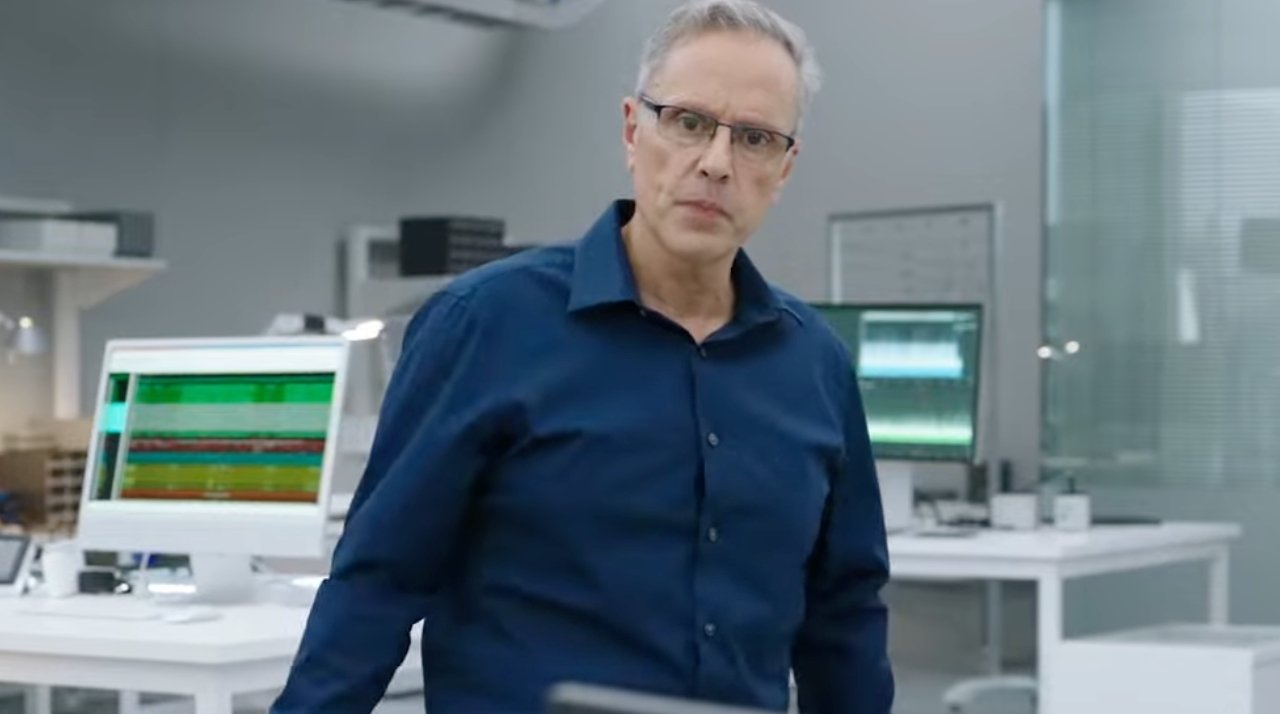Johny Srouji says Apple's hardware ambitions are limited only by physics
The Apple Silicon chips in the new MacBook Pro are just the latest result in Apple's years-long plan to control every element of its products, says Johny Srouji in a rare interview.

Johny Srouji during Apple's "Unleashed" event
As Apple's senior vice president, hardware technologies, Johny Srouji has been talked about as a successor to Tim Cook, and had been thought to be in line to take over Intel. Instead, he remains focused on developing Apple's processors, as he was when Steve Jobs recruited him in 2008.
Now as the new M1 Pro and M1 Max processors have been revealed, Srouji -- plus Apple's John Ternus and Greg "Joz" Joswiak -- have spoken about how the company got to this point. Talking to Wired, they all speak about how the aim was to have Apple design all it could, and the process was to work together.
"I always keep in mind that Apple is first and foremost a product company," said Srouji. "If you're a chip designer, this is heaven because you're building silicon for a company that builds products."
"When you're a merchant vendor, a company that delivers off-the-shelf components or silicon to many customers, you have to figure what is the least common denominator-- what is it that everyone needs across many years?" he continues.
"We work as one team-- the silicon, the hardware, the software, the industrial design, and other teams-- to enable a certain vision," says Srouji. "We sit together, and say, 'Okay, is it gated by physics? Or is it something we can go beyond?' And then, if it's not gated by physics and it's a matter of time, we go figure out how to build it."
Srouji says that Apple began its efforts "with the CPU first," and then it went into graphics. "Then we went into signal processing, display engine, etc.," he explains. "Year over year, we built our engineering muscle and wisdom and ability to deliver."
"Traditionally, you've got one team at one company designing a chip, and they have their own set of priorities and optimizations," he told Wired. "And then the product team and another company has to take that chip and make it work in their design."
"With these MacBook Pros, we started all the way at the beginning-- the chip was being designed right when the system was being thought through," continued Ternus.
Wired asked Ternus, Srouji, and senior vice president, worldwide marketing, Greg "Joz" Joswiak, about Google beginning to build its own silicon just as Apple has.
"Clearly, they think we're doing something right," said Joswiak.
Pressed for any advice Apple could give Google about working on new processors, Joswiak said: "Oh, I don't know. Buy a Mac."
Read on AppleInsider

Johny Srouji during Apple's "Unleashed" event
As Apple's senior vice president, hardware technologies, Johny Srouji has been talked about as a successor to Tim Cook, and had been thought to be in line to take over Intel. Instead, he remains focused on developing Apple's processors, as he was when Steve Jobs recruited him in 2008.
Now as the new M1 Pro and M1 Max processors have been revealed, Srouji -- plus Apple's John Ternus and Greg "Joz" Joswiak -- have spoken about how the company got to this point. Talking to Wired, they all speak about how the aim was to have Apple design all it could, and the process was to work together.
"I always keep in mind that Apple is first and foremost a product company," said Srouji. "If you're a chip designer, this is heaven because you're building silicon for a company that builds products."
"When you're a merchant vendor, a company that delivers off-the-shelf components or silicon to many customers, you have to figure what is the least common denominator-- what is it that everyone needs across many years?" he continues.
"We work as one team-- the silicon, the hardware, the software, the industrial design, and other teams-- to enable a certain vision," says Srouji. "We sit together, and say, 'Okay, is it gated by physics? Or is it something we can go beyond?' And then, if it's not gated by physics and it's a matter of time, we go figure out how to build it."
Srouji says that Apple began its efforts "with the CPU first," and then it went into graphics. "Then we went into signal processing, display engine, etc.," he explains. "Year over year, we built our engineering muscle and wisdom and ability to deliver."
One Apple
Specifically talking about this approach applied to the new MacBook Pro, John Ternus, vice president, hardware engineering, repeated Srouji's comment about teams working together."Traditionally, you've got one team at one company designing a chip, and they have their own set of priorities and optimizations," he told Wired. "And then the product team and another company has to take that chip and make it work in their design."
"With these MacBook Pros, we started all the way at the beginning-- the chip was being designed right when the system was being thought through," continued Ternus.
Wired asked Ternus, Srouji, and senior vice president, worldwide marketing, Greg "Joz" Joswiak, about Google beginning to build its own silicon just as Apple has.
"Clearly, they think we're doing something right," said Joswiak.
Pressed for any advice Apple could give Google about working on new processors, Joswiak said: "Oh, I don't know. Buy a Mac."
Read on AppleInsider



Comments
Should have said, “Shut it down and give the money back to the stockholders.” /s
I doubt they'll double up on SoC's. More than likely they'll go with much bigger SoCs variants, "M# Ultra" or "M# Extreme". They would be so far ahead in performance that they'll only need to update them half as often as the rest of the M1 family (basically the same as they did with the "X" variant in the A-series).
Well, I think Shruti said "crush" too. Always good to hear that word in that context.
There was an interview recently with the CEO of Qualcomm and he was asked why the US had screwed up its national efforts in the creation of 5G and he mentioned the fact that they had deliberately taken the decision not to produce 'end products' but to supply others.
'Rolling your own' isn't a better or worse decision per se. They are just two different approaches and feeding off Qualcomm has proven very successful for Apple for many years.
Johny is tacitly admitting this when he says that Apple started with CPU, graphics, signal processing etc. It's all relatively new to Apple and, of course, evidence of that is the lack of a homegrown Apple modem.
The claims of Apple teams working together in harmony are also a little jarring given the recent cases of 'new' technologies quickly becoming incompatible with newer versions. AI has seen quite a few comments over the last few months claiming Apple's left hand hasn't been aware of whar the right hand was doing. Mainly for consumer facing technologies. For the internal core technologies that isn't the case but that isn't the case virtually anywhere.
What he is doing is stating the obvious.
The 'doing something right' comment should really be taken as being successful in what they are doing, not the approach itself. Either approach is fine - provided it is successful. And there is never any guarantee of that.